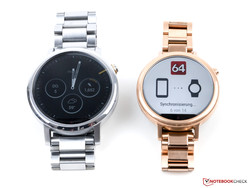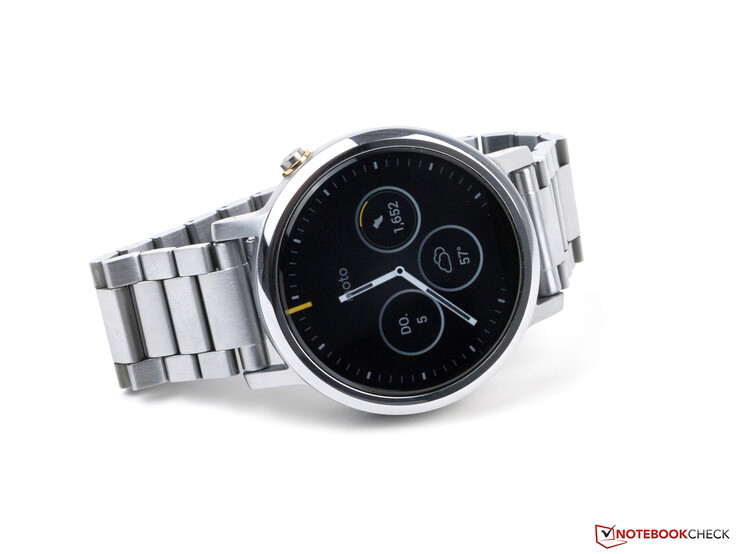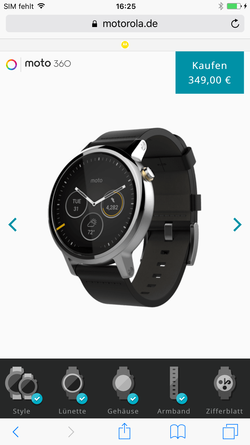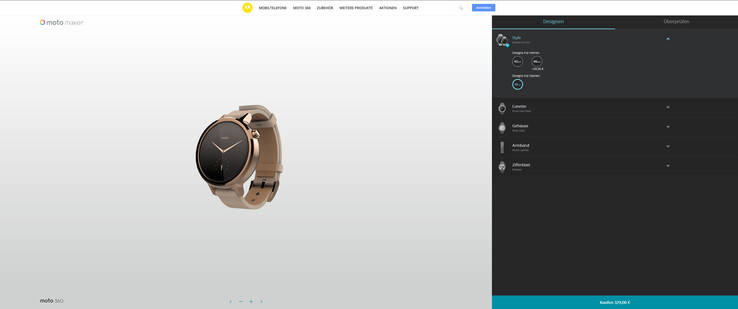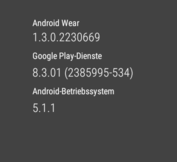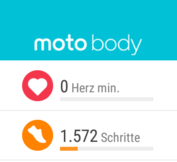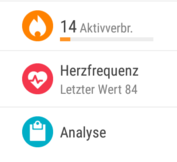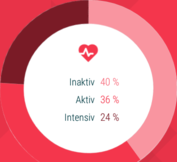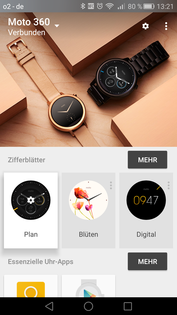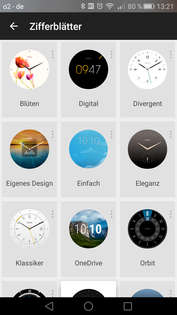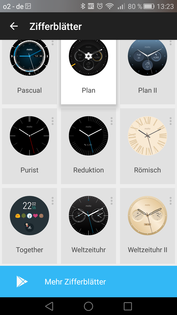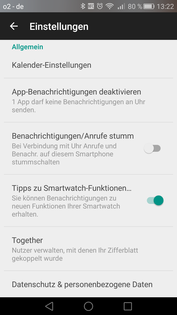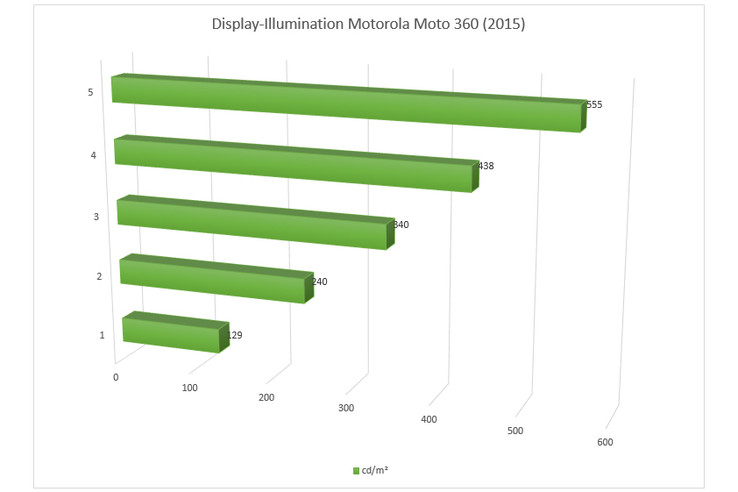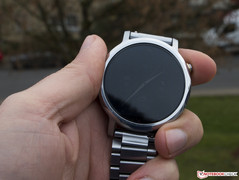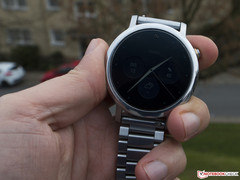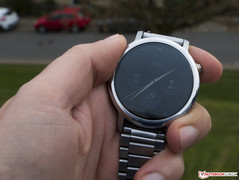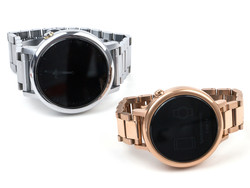Motorola Moto 360 (2015) Smartwatch Review
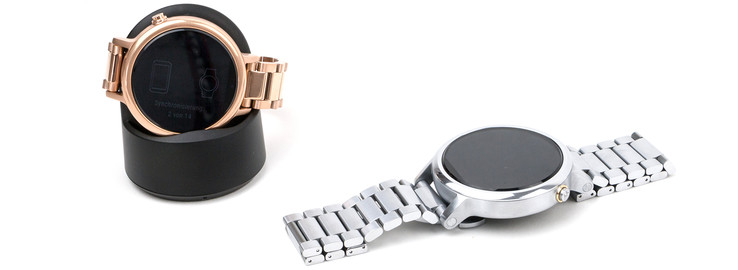
For the original German review, see here.
One typical quality of Motorola's smartphones is that their looks can be customized. That is also true for the smartwatches that are offered in three different base versions. There are distinct 42-millimeter (~1.56 inches) men's and women's model that is available for starting at 299 Euros (~$318). Besides that, a further 46-millimeter (~1.81 inches) model is offered exclusively for men. It costs 50 Euros (~$53) extra. The most expensive model can add up to a total price of 429 Euros (~$456).
Technically, the Moto 360 2nd Generation is not very different compared with other Android Wear based rivals. In addition to a Snapdragon SoC and heart-rate monitor, singularity unique feature for this sector is also found: An ambient light sensor for the display. How well it works and how well the smartwatch will fare in a comparison with its rivals can be read in the following report.
Case
All models of Motorola's Moto 360 (2015) feature a stainless steel casing. The underside is plastic though. The wristbands are optionally leather or stainless steel. Our review samples are a 46 mm men's and a 42 mm women's watch. Both have a stainless steel band. Like the Huawei Watch, they can be easily replaced via a quick-release fastener. The edges of these bands are quite sharp. Buyers who opt for a smartwatch with a stainless steel wristband should plan a visit to their jeweler's. It might be necessary to remove or add single elements of the band for a good fit. Additional elements are included. Particularly the women's band is quite tight in delivery state, making it primarily suitable for thin wrists.
The display of the Moto 360 is protected by Corning Gorilla Glass 3. Unfortunately, the integrated brightness sensor disrupts the actually circular clock face. That not only ruins the esthetics, but could in fact cover parts of the displayed content. The smartwatch's build is otherwise very good.
The wristband width is not the only difference of the men's and women's models, but also the display diagonal. While the height is always 11.4 millimeters, there is a smaller display with a diagonal of 1.37 inches for the 42 mm model and one with 1.56 inches for the bigger version. 16-millimeter (~0.64 in) wristbands are required for the women's watches; the men's version can be furnished with either a 20 or 22 mm (~0.79 or 0.86 in) wristband.
The weight of the watches also differs. The base of our men's watch weighs 46 grams (~1.6 oz) and adds up to 129 grams (~4.5 oz) with the wristband. Our women's model weighs 37 (~1.3 oz), respectively 92 grams (~3.2 oz).
Ordering Process
The ordering process for a customized Motorola Moto 360 is only possible via the Moto Maker. The company cordially allowed us to test this, and we would like to relate our impressions.
The configurator is very basic and clearly arranged, and its mobile version is easy to use with the fingers. The buyer is led through the process for customizing the smartwatch step by step.
First, the right model has to be chosen. The mentioned men's and women's models are offered for this. Motorola is currently the only manufacturer that also offers a model just for women. It differs in both the wristband width and length. The so-called bezel - the ring around the clock face - is selected after that. Here, three different colors and an optional pattern are available.
The color of the stainless steel casing is selected in the third step. Rose gold and gold both cost extra. The buyer is also spoiled for choice in the fourth step - choosing either a leather or stainless steel wristband. A double leather band is also available for the women's model. The last two options again cost extra.
Finally, the installed dial can be selected. It is not binding and can be changed at any time in the watch's settings. Every change is also displayed in the preview, visualizing a preliminary taste of the customized watch. As easy as ordering and customizing the watch via Moto Maker is, it often also has its price. Discounts are not offered, and experience shows that the price does not stay at the RRP.
Connectivity
The connectivity of Motorola's new Moto 360 is not much different from other competitors based on Google's Android Wear, for example the LG Watch Urbane or Huawei Watch. The review samples are also powered by a Qualcomm Snapdragon 400 SoC that can fall back on 512 MB of working memory and 4 GB flash memory. However, only the Moto 360 presently offers an ambient light sensor that automatically adapts the display's brightness.
A 3-axis accelerometer is installed. Huawei's smartwatch has twice as many axes, which becomes very evident in the pedometer's accuracy. The Moto 360 eagerly counts paces in real world use, and tends to add several steps when twisting the wrist vigorously. The heart-rate monitor regularly measures the pulse and records it, and also uses it to determine the wearer's activities. The analysis in the Moto Body app could be a bit more detailed.
A Wi-Fi module is also on board and enables transmitting notifications from the smartphone to the Moto 360 when a Bluetooth connection is not available. The smartphone retrieves the necessary network access data from the phone. This feature is quite convenient when the smartphone is not permanently at hand, and the user does not want to miss any notifications. Bluetooth 4.1 rounds off the wireless package.
Software
At test time, Google's latest Android Wear 1.3.0 operating system was installed. The minimum requirement for smartphones that are to be coupled with the Moto 360 is Google's Android 4.3 Jelly Bean or Apple's iOS 8.2.
The handling of the latest Android Wear version has not been modified greatly. However, considerably more apps are now compatible with the operating system. Notifications from common messenger services can be received just like emails or reminders. Even sport standings, news and other events are transmitted reliably to the smartwatch.
Motorola is a bit tightfisted in terms of included watch faces. The user can only select from 18 dials directly. However, more can be downloaded from Google's Play Store.
Accessories
The Moto 360 is shipped with a power supply with a non-removable charging cable, and a charging dock. The latter is wireless, and thus the smartwatch does not need charging contacts on its lower edge. That also functioned impeccably in practice. A nice side effect is that the watch turns into a kind of small bedside clock while recharging. The display's color can be changed simply by swiping. The charging dock is surprisingly heavy, but also has a good grip on sleek surfaces thanks to its rubberized underside.
Warranty
Motorola only includes a twelve-month warranty on its product. The implied warranty remains valid.
Display
Unlike LG or Huawei, Motorola again relies on an LC display for its smartwatch that is protected by Corning Gorilla Glass 3. The screen's size, like in the predecessor, is again 1.56 inches in the big model for men, and both 42 mm versions have 1.37-inch display. With 360x330 and 360x326 pixels (46 & 42 mm versions), the pixel density is somewhat below that of the rivals. The pixel density remains clearly below 300 PPI in both versions, and pixelation is visible.
The brightness in manual mode is surprisingly high and reaches up to 555 cd/m² in the highest level. We did not notice any further improvements when the ambient light sensor was enabled. A good rate anyway.
However, the measurements confirm our premonitions concerning the display's subjective impression: The black level is relatively high and reaches 0.57 cd/m² in maximum brightness. The Moto 360 can thus only offers dark gray compared with the rivals with an OLED display. The contrast ratio of 974:1 is good.
| |||||||||||||||||||||||||
Center on Battery: 555 cd/m²
Contrast: 974:1 (Black: 0.57 cd/m²)
Outdoor use proves that brightness is not everything. Despite the considerably higher light density, Motorola's Moto 360 does not perform as well as, for example, the Huawei Watch with an AMOLED display that benefits from a much better contrast ratio.
The biggest advantage is that the required brightness is set automatically via the ambient light sensor. Although that sometimes takes a few seconds, it functions very well. Thus, there are no problems with the screen's legibility on a sunny fall day and even more under cloudy skies. It however will look different in the summer.
Energy Management
Battery Runtime
Motorola's Moto 360 is a bit taller and has a bigger display diagonal, but its battery is not larger than in the competition. It only supplies 300 mAh. LG's even has 410 mAh. The smartwatch allegedly lasts for as long as one and a half days.
However, this rate is hardly possible using a permanently enabled display and Wi-Fi. The battery only displayed a rest capacity of 25 percent after 12 hours. That will at most be enough for a day. Users who receive many notifications and are outdoors a lot will have problems reaching even that. Turning off the screen occasionally or not using Wi-Fi can extend the battery life noticeably. However, those are nice features that most users will not want to miss.
Pros
Cons
Verdict
The second generation of the Moto 360 provides the customer with a nice smartwatch that can be configured and customized like no other. Unfortunately, Motorola has not reworked crucial aspects. The brightness sensor disrupts the circular display, which ruins the looks. Furthermore, the sensors do not yet function as accurately as in other competing products.
The manufacturer has improved the performance a bit and installs a fast Snapdragon SoC. The display is also very bright and can adapt its brightness according to the ambient light. The casing and wristbands now make a very high-quality impression and are even dust and water resistant.
Stylish, customizable, but also with minor imperfections: the Moto 360 (2015).
The smartwatch is quite convincing, but also has a comparatively high price. It can get expensive especially when the gadget is customized by the buyer. Motorola should also improve the battery life.




